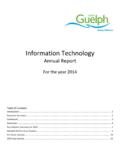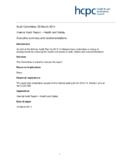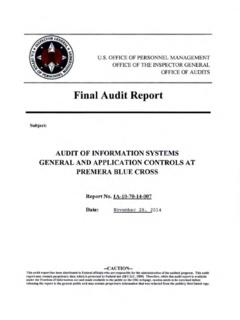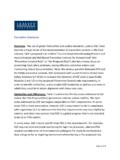Transcription of INTERNAL AUDIT REPORT - City of Guelph
1 CAO-A-1408 Appendix A INTERNAL AUDIT REPORT LEARNING AND DEVELOPMENT final August 1, 2014 Prepared by: Loretta Alonzo, INTERNAL Auditor Learning and Development AUDIT Report2 Table of Contents EXECUTIVE SUMMARY .. 3 Executive Summary - Key Findings and Recommendations .. 3 AUDIT OBJECTIVES .. 4 SCOPE .. 4 AUDIT TEAM .. 5 METHODOLOGY .. 5 CORPORATE OVERVIEW .. 5 Current Environment .. 5 CORPORATE SUMMARY KEY FINDINGS AND RECOMMENDATIONS .. 7 CORPORATE FINANCIAL ANALYSIS .. 9 STAKEHOLDER INTERVIEW AND SURVEY DATA .. 11 BENCHMARKING .. 15 OPERATIONS, TRANSIT AND EMERGENCY SERVICES FINANCIAL ANALYSIS .. 17 PLANNING, BUILDING, ENGINEERING AND ENVIRONMENT FINANCIAL ANALYSIS .. 18 COMMUNITY AND SOCIAL SERVICES FINANCIAL ANALYSIS.
2 19 CORPORATE AND HUMAN RESOURCES FINANCIAL ANALYSIS .. 20 FINANCE AND ENTERPRISE FINANCIAL ANALYSIS .. 21 CONCLUSIONS .. 21 NEXT 22 Learning and Development AUDIT Report3 EXECUTIVE SUMMARY Executive Summary - Key Findings and Recommendations Learning and Development (L&D) encompassing all forms of training, is an essential component of today s Learning Organization . In order to keep pace with the rapidly changing environment of technology, legislative requirements and best practices in business performance and customer service delivery, it is imperative that staff are equipped with the knowledge and tools to achieve optimum results for the organization. The primary objective of this operational AUDIT was to identify what the City is currently spending on L&D and to benchmark our existing programs and structure with other organizations in terms of best practices, effectiveness, accessibility and selection of L&D opportunities for City staff.
3 Our AUDIT research confirmed that the current decentralized model of administering L&D is most common among our municipal comparators and is largely effective for the City. This means that each department establishes and controls its own L&D budget and training decisions. The Human Resources department takes primary responsibility for specific types of training such as Health and Safety, Tuition Reimbursement, Wellness and corporate training and development. While no major issues were identified in the service delivery structure for L&D, there are some significant gaps in specific forms of training that should be addressed. Extensive stakeholder input was gathered for this AUDIT and the results were highly consistent across the organization.
4 Health and Safety training was highly rated by the majority of staff as was orientation, onboarding and soft skill training such as diversity, respectful workplace etc. One of the issues of greatest concern for more than 85% of staff respondents is the lack of training in corporate software programs such as RAC , WAM , KRONOS AMANDA , etc. as well as the lack of training in Customer Service, Budgets and Office software programs. The current practice to obtain corporate software systems training leaves most employees on their own to arrange training with one of the super users in each respective area (Finance, Procurement, HR etc.) This is ineffective, inconsistent and relies on the willingness and availability of other staff to provide training that is not part of their function or responsibility.
5 Financial analysis conducted for the AUDIT identified that nearly 100% of L&D budgets are underspent year over year by an average of 30%. This often occurs when discretionary spending is curtailed to mitigate projected budget deficits. In order to truly become a Learning Organization and support one of the City s strategic directions ( Engage employees through excellence in leadership) the City will have to accept that Learning and Development plans and commitments are not discretionary and should be maintained. Learning and Development AUDIT Report4 Municipal benchmarking data was somewhat difficult to obtain, particularly for financial comparisons, as most organizations, like Guelph , have decentralized L&D budgets and are not able to provide financial data at the department level for the purpose of comparing our costs.
6 Some of the comparisons used for the AUDIT were taken from the HR Annual REPORT based on the Conference Board of Canada statistics. We note that there is presently no corporate Learning and Development Policy and acknowledge that HR staff have established a new policy which they are ready to formally implement pending the completion of this AUDIT . It is anticipated that the new policy will address many of the concerns expressed by staff in terms of equity, accessibility and effectiveness of training. The key findings and recommendations identified in the AUDIT are summarized in Chart 1 on page 8 of this REPORT . AUDIT OBJECTIVES The following objectives were established for this operational AUDIT : Identify what the City is currently spending on all forms of Learning and Development Evaluate financial reporting and transparency of training dollars spent Identify best practices and benchmark the City with other organizations to determine what will be required for the City of Guelph to implement these practices Assess the effectiveness, accessibility and selection of learning and development opportunities for City staff Inform the ongoing development of a Corporate Learning and Development policy SCOPE The scope established for this AUDIT includes: Analysis of all Learning and Development costs (3 years historical, Budget vs.)
7 Actual). Compare size of budgets by department and number of employees. Classification of all related costs by type; Health and Safety, Legislated Training, Professional Development, etc. Evaluate existing system and other IT training; WAM, RAC, JDE, AMANDA, etc. Stakeholder evaluation of existing training programs Municipal Benchmarking Learning and Development AUDIT Report5 AUDIT TEAM Loretta Alonzo, INTERNAL Auditor Katherine Gray, Business Performance Specialist Adrian van Eck, Supervisor, Inspection Services METHODOLOGY The following research and analysis was undertaken for this AUDIT : Staff-Stakeholder interviews o Online survey (49 completed) o Paper survey (83 completed) o Personal interviews Executive Team / DRLT (16 completed) o Standing Committee Chairs o Compliance Training staff (2) o Health and Safety staff (2) o Key Human Resources staff (6) INTERNAL documentation review and analysis o Human Resources, Annual Reports 2008-2013 External Literature review Municipal Comparators Benchmarking Financial Analysis (Object codes 3400-3480) CORPORATE OVERVIEW Current Environment Learning and development, encompassing all forms of training, is an essential component of today s Learning Organization.
8 In order to keep pace with the rapidly changing environment of technology, legislative requirements and best practices in business performance and customer service delivery, it is imperative that staff are equipped with the knowledge and tools to achieve optimum results for the organization. The City of Guelph strives to ensure that the organization meets the needs of employees and the community by providing learning and development opportunities in a variety of forms. The benefits to the organization include: Employees who are continuously learning are better prepared to help the organization achieve its goals Learning and develop programs ensure staff are more engaged, productive and motivated Well trained staff require less supervision A skilled pool of employees are ready to replace others who leave Learning and Development AUDIT Report6 Staff that engage in continuous learning are better able to meet the challenge of changes in the organization The City can attract and retain the best employees Our AUDIT research confirmed that the current decentralized model of administering L&D is most common among our municipal comparators and is largely effective for the City.
9 This means that each department establishes and controls its own L&D budget and training decisions. The Human Resources department takes complete responsibility for specific types of training such as Health and Safety, Tuition Reimbursement (LEAP program), Wellness and corporate training and development. While no major issues were identified in the service delivery structure for L&D, there are some significant gaps in specific forms of training that should be addressed. Extensive stakeholder input was gathered for this AUDIT and the results were highly consistent across the organization. Health and Safety training was highly rated by the majority of staff as was orientation, onboarding and soft skill training such as diversity, respectful workplace etc.
10 One of the issues of greatest concern for more than 85% of staff respondents is the lack of training in corporate software programs such as RAC, WAM, KRONOS, etc. as well as the lack of training in Customer Service, Budgets and Office software programs. The current practice to obtain corporate software systems training leaves most employees on their own to arrange training with one of the super users in each respective area (Finance, Procurement, HR etc.) This is ineffective, inconsistent and relies on the willingness and availability of other staff to provide training that is not part of their function or responsibility. We acknowledge that establishing formal training programs for these specific areas will require significant planning and resources.











